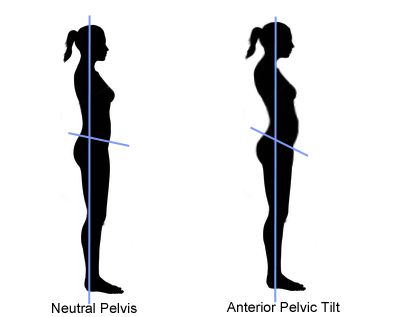Your posture is key: fixing anterior pelvic tilt

There is a lot of research on exaggerated pelvic tilt in athletes and how it is linked to injuries, particularly in the hamstrings and lower back. Anterior pelvic tilt, or forward rotation of your hip forwards creates excessive hip flexion. This can compromise your running performance by causing pain while running and by increasing your risk of an injury. In general, humans are at increased risk of anterior pelvic tilt. Most of us sit at a desk all day, which results in inactive glute muscles, tight hips and poor posture. Further, as runners, there are a number of things we are doing to further the problem.

We have tight hips and spinal erectors
We put a lot of pressure on our bodies, training for races and pushing ourselves to run faster and through various conditions, only adding to our hip tightness. Tight hips will pull our hips down, making it more difficult to consciously correct your pelvic tilt. As you run, your hip flexor acts by bringing your thigh towards your stomach. When your hips get tight and you attempt to run your body will adjust to help re-create the movement by doing so with an exaggerated pelvic anterior tilt. With an arch in your lower back, you will only perpetuate the issue, worsening your posture, weakening your core and potentially making your hips even tighter.
In addition, tight spinal erectors pull your hips forward, and if your glutes are weak they are unable to rectify!
How to help this? If you’re feeling extra tight, try a restorative pose like pigeon pose. To do this, begin in downward dog and bring your left knee forward to the floor just behind your left hand. Outwardly rotate your left thigh so that your left foot is in front of your right knee, shin on a 45-degree angle on the floor. Flex your left foot. Send your right leg behind you until your leg is fully extended with your shin, knee and thigh in contact with the floor. Draw your inner thighs towards each other, slightly lifting your pelvis higher. Find the midpoint where equal weight is between your left and right sides, and your pelvis is squared to the front of your mat. On an inhale, send your tailbone down towards the earth and the crown of your head up towards the sky. Exhale and slowly walk your hands forward in front of you, placing elbows on the floor or arms extended in front of you with torso on the floor. Breathe slowly for at least five deep breaths.
We have weak glutes
While running does strengthen our legs, unfortunately, our glutes are not being strengthened like the rest of our muscles (your hamstrings and calves just keep getting bigger and stronger!) And let’s be honest with, when you hit the gym for a cross-training session, you’re likely incorporating squats or leg presses into your workout. Weak glutes require your hamstrings to work overtime which means your hamstrings are more prone to injury. If you do not strengthen your glutes, it may mean an endless cycle of problems – the anterior pelvic tilt will make your hamstrings feel even shorter making exercising and stretching more difficult.

How to help this? There are quite a few yoga exercises that can help to strengthen your glutes. One of our favorites is bridge pose. To do this pose, lie on your back and bend your knees so the soles of your feet are pressing into the floor. Feet should be hip-width apart. Walk your feet in towards your hips so that you can touch your heels with your fingers. Root your hands, forearms and shoulders into the floor. Rotate the outer edges of your arms towards the ground, lifting your chest. Keep your knees over your feet, rotating your thighs inward. Lift your hips towards the ceiling, keeping your head and neck relaxed. Take a few breathes in this position. To come out of the pose, gently lower to the ground on an exhalation rolling the spine down slowly.
We need stronger core muscles
An anterior tilt means your hips consistently pull down, but strong abdominal muscles can help to pull your hips back up. While we know cross-training is important, we likely are not spending enough time developing our core.
How to help this? Try a challenging core strengthening pose like side plank. To do this, come into plank pose with your hands pressing away from the mat to engage your forearms (and protect your wrists). Your shoulders should be directly above your wrists. Engage your core and roll your hips to the right, coming onto the outside edge of your right foot. Stack the left foot onto the right foot. Place your hand slightly in front of the shoulder so it’s not directly below the shoulder. Take a deep inhale and raise your left arm so your fingers are pointing at the ceiling. Try to hold for 15-30 seconds on each side and repeat.


